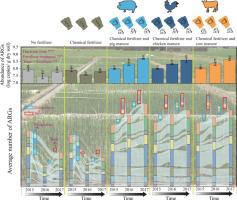Journal of Hazardous Materials ( IF 12.2 ) Pub Date : 2020-07-06 , DOI: 10.1016/j.jhazmat.2020.123399 Wenbo Liu 1 , Ning Ling 1 , Junjie Guo 1 , Yang Ruan 1 , Min Wang 1 , Qirong Shen 1 , Shiwei Guo 1

|
The application of animal manure is generally considered an important transmission pathway for antibiotic resistance genes (ARGs) in soil. Nevertheless, the fate of ARGs in soil where manure from different sources has been repeatedly implemented is not fully understood. Thus, the succession of ARGs and bacterial communities following the repeated application of three types of animal manures (pig, chicken, and cow manure) to agricultural soil were investigated using Illumina sequencing analysis and high-throughput qPCR. Results showed that manure application remarkably increased the abundance of soil ARGs by increasing the enrichment of indigenous ARGs and introducing extrinsic ARGs. There were no prominent differences in the abundance or diversity of ARGs among the three different manured soils. The abundance and diversity of ARGs in manured soils increased over three consecutive years. Additionally, the abundance of mobile gene elements (MGEs) and bacteria were positively correlated with ARGs, while the changes in the ARG profiles were dramatically associated with the MGEs and bacterial communities. These findings imply that repeated manure application may facilitate to the accumulation and persistence of the soil resistome by regulation of the bacterial community and horizontal gene transfer, providing better insights into the temporal dynamics of soil ARGs in agro-ecosystems.
中文翻译:

连续三年用不同来源的动物粪便修正了农业土壤中抗生素抗药性的变化。
动物粪肥的施用通常被认为是土壤中抗生素抗性基因(ARG)的重要传播途径。然而,人们仍然不完全了解ARGs在土壤中反复施用不同来源的肥料的命运。因此,使用Illumina测序分析和高通量qPCR研究了将三种类型的动物粪肥(猪粪,鸡粪和牛粪)重复施用于农业土壤后的ARG和细菌群落的演替。结果表明,通过增加原生ARG的富集和引入外源性ARG,施肥显着增加了土壤ARG的丰度。在三种不同的施肥土壤中,ARG的丰度或多样性没有显着差异。肥料土壤中ARG的丰度和多样性连续三年增加。此外,丰富的移动基因元件(MGEs)和细菌与ARGs正相关,而ARG图谱的变化与MGEs和细菌群落显着相关。这些发现表明,重复施肥可以通过调节细菌群落和水平基因转移来促进土壤抵抗力的积累和持久性,从而更好地了解农业生态系统中土壤ARG的时间动态。











































 京公网安备 11010802027423号
京公网安备 11010802027423号